Marisa McClellan's Blog, page 49
February 2, 2017
February Sponsors: Cuppow, Fillmore Container, EcoJarz, MightyNest, and Mason Jar Lifestyle

Happy February, dear readers! It’s time to thank the businesses that help make this site possible. Please do give them a little love if you feel so moved!
In the top spot are our friends at Cuppow. They are the creators of the original mason jar travel mug topper and the BNTO, a small plastic cup that transforms a canning jar into a snack or lunch box. Parents and kids love their EIO set, with its grippy silicone sleeve and a lid that makes for easy sipping. And make sure to check out their Cup Club, to see if using a mason jar and cuppow can earn you free coffee at a shop near you!
Lancaster, PA-based and family-owned Fillmore Container are next! They sell all manner of canning jars, lids, and other preservation gear. As always, their blog is an amazing resource for all things jar-related. They just recently posted a recipe for Grapefruit Rosemary Jam that looks absolutely delicious.
Our friends over at EcoJarz are back again this month. They make an array of products designed to fit on top of mason jars, including cheese graters, coffee brewers, and stainless steel storage lids. Just in time for Valentine’s Day, they’ve got a number of jar and accessory sets on sale!
MightyNest is an amazing resource for non-toxic, natural, and organic products for homes and families. I’m a big fan of the MightyFix, their monthly product subscription program. Right now, you can get a year’s subscription to the MightyFix for just $99 (it regularly costs $10 a month, so that’s a great deal). Best of all, if you’re a new subscriber, you can get the first month for just $1.
Mason Jar Lifestyle is a one-stop shopping site for all the jar lovers out there. They sell all manner of mason jar accessories and adaptors. If you’re in the market for lids, straws, and cozies to transform your mason jars into travel mugs, make sure to check them out!
If your company or small business is interested in becoming a sponsor, you can find more details here. I offer discounts for multiple month purchases and am always happy to work with your budget. Leave a comment on this post or drop me a note to learn more!
Related Posts:
January Sponsors: Cuppow, Fillmore Container, EcoJarz, iLids, MightyNest, and Mason Jar Lifestyle
December Sponsors: Cuppow, Fillmore Container, EcoJarz, iLids, MightyNest, Mrs. Wages, Hobby Hill Farm, & Mason Jar Lifestyle
October Sponsors: Cuppow, Fillmore Container, EcoJarz, and More!
February 1, 2017
Salt Preserving for the February Mastery Challenge
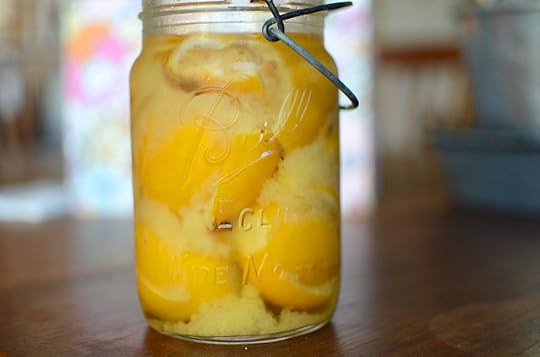
It’s the first of February and that means it’s time to take on the second project in the Food in Jars Mastery Challenge. This month is all about salt preserving. For the purposes of this challenge, we’re going to focus on dry brining or curing. Think salt preserved citrus, salt preserved herbs (herbes salees), gravlax, cured egg yolks, sauerkraut, infused salts, and kimchi. We’re going to stay away from meat and wet-brined ferments.
Remember that the goal of this challenge is to help you expand your skills while creating something that you’ll actually use. So choose a project or recipe that will satisfy both your own learning and help you make something delicious.

The Recipes
You don’t have to choose one of these recipes, but there’s some good stuff here. Feel free to use one or use them as a jumping off point for your own research and exploration.
Salt preserved lemons – This is an easy starting point. I make at least one batch of these every year. They add a tangy, funky bite to soups and stews. I often heap a bunch of them in the blender and puree them smooth. I dollop that puree into hummus, vinaigrettes, and other creamy spreads.
Salt preserved key limes – Some readers argued whether the fruit I used were in this project were actually key limes, but that’s what the bag said. They’re zippy and bright and worth the making.
Citrus salt – Another really simple one. Zest a bunch of lemons, limes, grapefruits, or oranges and combine them with chunky salt. Spread it out on plate or parchment-lined cookie sheet and let it air dry. Then sprinkle it over chicken, fish, dips, and roasted vegetables.
Herb salt – A variation on the citrus salt above, this expansive, wide-ranging recipe is flexible and adaptable.
Herbes salees – There’s a version of this recipe in my second book, but I learned everything I know about salt preserved herbs from Joel and Dana at Well Preserved. And so if their post was a good starting place for me, it’s a good starting place for you!
Gravlax – Quick cured and seasoned salmon that takes a few minutes to prep and just a couple days in the fridge to get good. It’s a low effort, high reward project and just the thing to make if you’re planning a dinner party or fancy brunch.
Cured egg yolks – I’ve not made these before, so I point you in the direction of Hank Shaw for instructions here. From what I hear, this relatively quick cure produces something with the flavor and depth of good cheese.
Kraut – There’s so many directions to go here. Start with a recipe that appeals and begin to explore.
Kimchi – This is my favorite approach, but it just one of many. If you decide to go in this direction, do try to stay away from the brined recipes and stick to the ones that are salted directly, as we’ll focus on wet brined foods later in the year.
As always, I’ll spend the next month posting recipes and troubleshooting guides focused on this month’s topic. Alex will also have a post that will feature her project. More soon!
Related Posts:
Preserving Lemons
Mastery Challenge January Round-up: Marmalade
Lemon Lime Marmalade
January 31, 2017
Mastery Challenge January Round-up: Marmalade
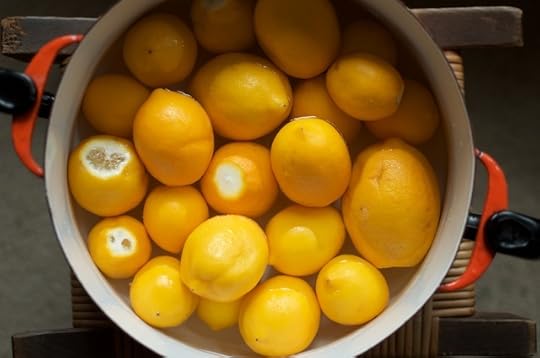
Well friends, I think we can safely say that the first month of the Food in Jars Mastery Challenge was a resounding success. Currently, there are just over 1,500 of you signed up via our email list and nearly 600 of you submitted a project for the final tally and round-up.
You turned blueberries, bergamot, cherries, clementines, cranberries, figs, ginger, grapefruit, key limes, kiwis, kumquats, lemons, limes (Persian, Bearss, and Makrut varieties all abound), mangoes, Meyer lemon (the most popular single fruit variety in the challenge), onions, oranges (including blood, Cara Cara, honeybell, mandarin, Minneola, navel, satsuma, and Seville), pears, pineapple, pomelo, rhubarb, strawberries, tomatoes, tangelo, yuzu, and zucchini.
There were also a few unexpected ingredients, including champagne, rice wine vinegar, and a grudging willingness to participate (I saw that, Janet).
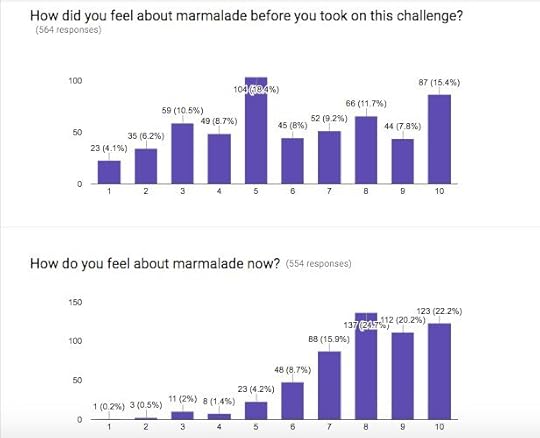
For 61% of you, this was the first time you ever attempted to make marmalade. The remaining 39% of you who had done it before. And while I’m not a statistician, I do believe that the charts above tell us that most of you are feel more warmly towards marmalade than you did at the beginning of January.
Now, on to the marmalades. Because of the high number of participants, I’m not able to include everyone in the round-up. But I am going to do my best to ensure that a goodly number of you are represented here.
Blood Orange Marmalades
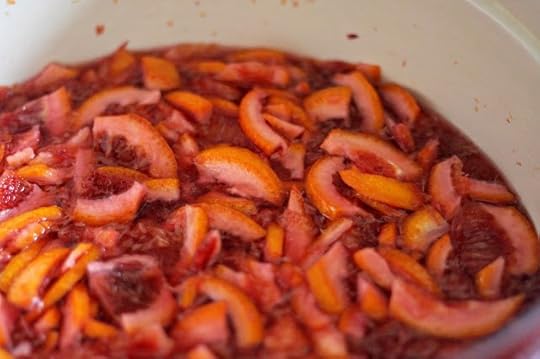
Slivers of blood oranges on their way to becoming marmalade – Kitchen Commentary
Blood Orange Marmalade – Kitchen Commentary
Angostura Blood Orange Marmalade – Putting Up With Erin
Blood Orange Meyer Lemon Marmalade – snowmonkeyplum
Blood Orange Marmalade – Uncanny Preserves
Pink Blood Orange Marmalade – jules2384
Blood Orange and Ginger Marmalade – dorylory
Raw Sugar Blood Orange Marmalade – Charyl Ward
Tiny Batch Blood Orange and Ginger Marmalade – yummysmellsca
Blood Orange, Meyer Lemon, and Limoncello Marmalade – tammyrwaterhouse
Blood Orange Aperol Marmalade (among many other versions!) – carololsen14
Blood Orange Chili Marmalade – Matt Bernier
Blood Orange Marmalade – Happily Homegrown
Blood Orange Marmalade (second time’s the charm) – jla1893
Blood Orange Marmalade (third time’s the charm!) – Mindy Friedmann Duff
Blood Orange Marmalade (sounds like things got a little loopy here) – Casula Mellita
Small Batch Blood Orange Marmalade (and some useful thoughts on the process) – Tesla Anomaly
Light Blood Orange Marmalade – A Smidgen of Joy
Cara Cara Oranges
Nicely set Cara Cara Orange Marmalade – rachelegger
Cara Cara and Meyer Lemon Marmalade – East of Eden Cooking
Cara Cara Marmalade – Gone Walkabout 2
Cara Cara Orange and Vanilla Marmalade – Shades of Bliss
Cara Cara Marmalade – knittygirl2
Long-cooked Cara Cara Thyme Marmalade – breakfastquest
Step-by-step Cara Cara Orange Marmalade – Sustainable Maine
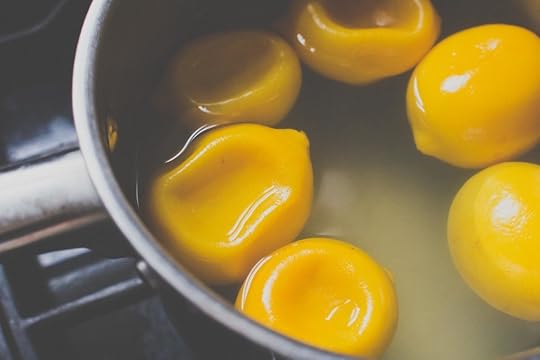
Cooking down the lemons – My Bit of Earth
Oranges
Orange Lemon Marmalade – Gardenbre
A round-up of marmalades for the round-up – Cooking with Mary and Friends
Cranberry Orange Marmalade – wlmich
Clementine Amaretto Marmalade – Amy Costain Weltner
Clementine Earl Grey Marmalade – Marian Allen
Clementine Meyer Lemon Marmalade – Kelly McCracken Kerr
General Tso’s Marmalade (spicy!) – Jersey Knitter
Grand Marnier Orange Marmalade – Gin’s Kitchen
Instant Pot Orange Marmalade – Nomnivorous
Pretty Orange Marm – Katie Fleischman
Bread Machine Orange Marmalade – The Scholarly Redneck
Clementine Marmalade – Les Campagnonades
Locavore Marmalade in Canada – Jams and Chutney
Orange and Campari Marmalade – Jarla!
Orange Honey Marmalade with Scotch, Clove, and Cinnamon – Well Preserved
Navel Orange Marmalade – She’s Almost Always Hungry
Orange Marmalade – Canarella
Instant Pot Orange Marmalade – This Gal’s Take on Things
Orange Peach Marmalade – Jarstar
Orange and Tangerine Marmalade – Thoughts and Reflections
Small Batch Orange Marmalade – C’est La Vie
Satsuma and Clove Marmalade – Cheese and Cracker Jacks
Orange and Lemon Marmalade – Inside the Shell
Grapefruit
Grapefruit Bourbon Marmalade – jadcarr
Grapefruit Sea Salt Marmalade – therubbishrevolution
Grapefruit Rose Marmalade – Joel Palmer
Grapefruit Marmalade with Lemongrass and Basil – Hadley Allen
Grapefruit Marm – Casey DelliCarpini
Grapefruit Rosemary Marmalade – Roseanne Bowers Morison
Three Citrus Marmalade – The Earl House
Pink Grapefruit Marmalade – My Savory Spoon
Pink Grapefruit, Lemon, and Orange Marmalade – Morris Brook Farm
Lemon (Meyer and Other)
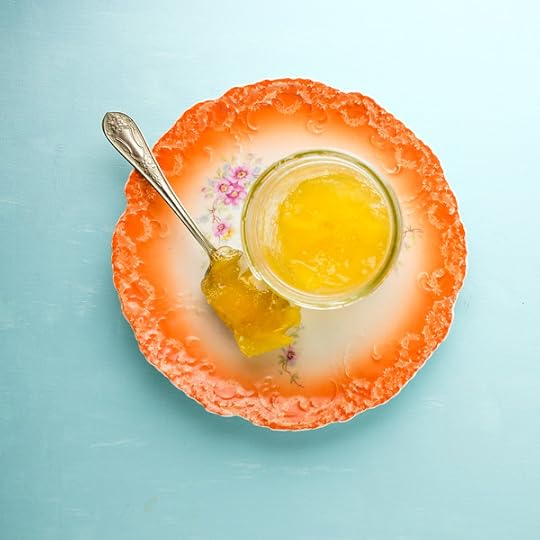
Lemon and mango marmalade – Sidewalk Shoes
Spicy Lemon(?) Marmalade – Victory Canning
Lemon Lavender Marmalade – Purlewe An
Lemon Elderflower Marmalade – A Plateful of Happiness
Lime, Lemon, and Honey Marmalade – Brit in the South
Seville Orange and Meyer Lemon Marmalade – Fermentina
Meyer Lemon and Elderflower Marmalade – Love & Wild Honey
Meyer Lemon Marmalade – My Bit of Earth
Meyer Lemon Marmalade – Kitchen Gadget Girl/Food in the Kitchen
Mineola and Meyer Lemon Marm – Haddon Musings
Strawberry Lemon Marmalade (29 of you made variations on this marm) – knitatnite
Strawberry Lemon Marmalade – First Things First
Reluctant Marmalade – A Raisin and a Porpoise
One more Strawberry Lemon Marmalade – mwearsch
Other Assorted Sweet Marmalades
Citrus Marmalade – Ever Growing Farm
Mixed Citrus Marmalade (with a bit of a disaster story) – Hip Roof Barn
Blueberry Ginger Orange Lime Marmalade – muffinlady01
Calamansi Marmalade – Homesteading on the Homefront
Cinnamon Fig Orange Marmalade – It’s Okay to Eat the Cupcake
Cherry Marmalade – Cooking with Mary and Friends
Texas Marmalade – Maura Sharp
Blueberry Citrus Marmalade – Melissa Kenney Slaght
Drunken Cherry Lemon Marmalade – Canning and Cooking at Home
Cranberry Clementine Marmalade – It’s All About the Journey
Kumquat Marmalade – Just Another Day on the Farm
Vanilla Kumquat Marmalade – Seed to Pantry
Mango Marmalade – Sidewalk Shoes
Cocktail Marmalade – Liz vz Projects
Savory Marmalades
Cranberry Onion Marmalade – My Catholic Kitchen
So many marmalades! – Amy Rummenie
A huge thank you to all of you who participated in this challenge! So sorry that I wasn’t able to include everyone in the round-up, but if I didn’t get to you this month, I’ll do my best to include you next time!
Related Posts:
Salt Preserving for the February Mastery Challenge
Lemon Lime Marmalade
Mastery Challenge: Meyer Lemon Grapefruit Marmalade
January 30, 2017
Giveaway: Meyer Lemons from Lemon Ladies Orchard

For the last six years, the highlight of my January has been the day the box of Meyer lemons arrives on my doorstep from the Lemon Ladies Orchard in Emerald Hills, California. My whole apartment fills with their fragrance the moment I unseal the box and I spend the next week or so making marmalade, syrups, curds, preserved lemons, and dehydrated rounds.
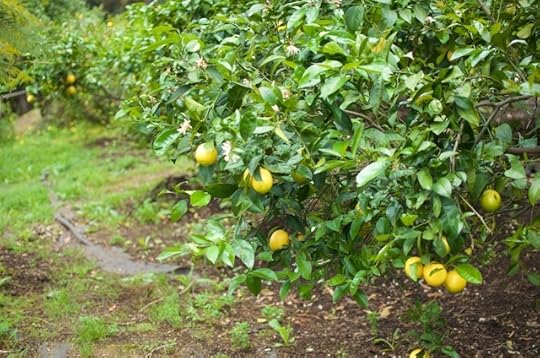
Last April, while I was on the first leg of my book tour, I spent a little time visiting Lemon Ladies and getting to know the owner, Karen Morss (she even put me up one night, which was incredibly kind of her).
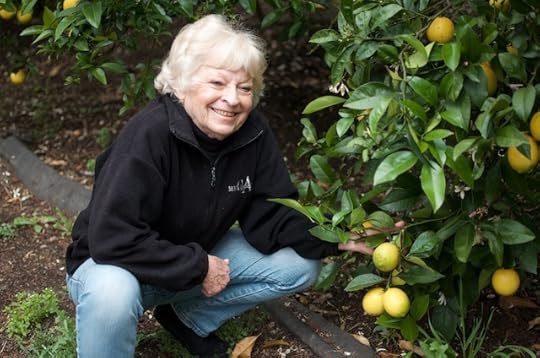
In the morning, Karen took me on a tour of the orchard, which is tucked into her backyard. She introduced me the 40 trees that make up the orchard (each named after a different woman who had inspired her) and told me about the joys and challenges of growing fruit.
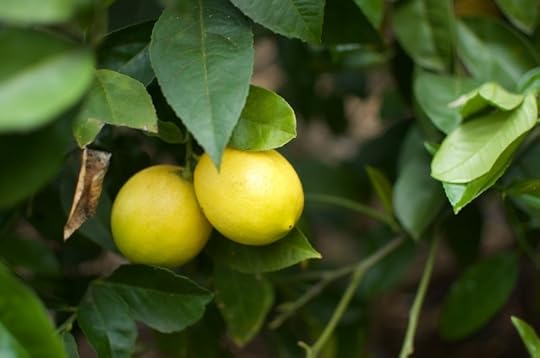
Karen uses organic fertilizer, ladybugs, and love to raise her lemons and it shows in her gorgeous fruit. I am forever in awe of the fact that such glorious fruit just grows on trees in California (I realize it sounds ridiculous, but in the depths of Pennsylvania winter, such things don’t seem entirely possible).

For this week’s giveaway, Karen has offered up a gift box of her lemons to one lucky winner. This prize has a $30 value and contains 3 1/2 pounds of juicy, fragrant Meyer lemons. Use the widget below to enter!
Related Posts:
Giveaway: Baller Gear from Biscuit Press
Giveaway: Smooth Sided and Mini Jars from Ball Canning
Links: Linzer Cookies, Dorie’s Jammers, and Winners
January 29, 2017
Links: Marmalade, Pickles, and Winners
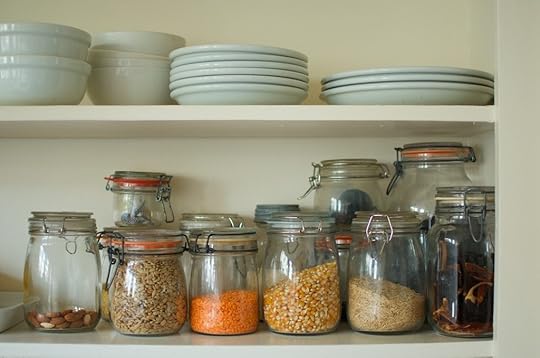
Lately, I have been finding great deal of comfort in cooking and sharing food. In the last couple weeks, friends have had babies, while others have experienced the unexpected loss of loved ones. Other dear ones are feeling disheartened and angry at the policies coming out of Washington and have needed the solace of a communal meal. I’ve made oatmeal chocolate chip cookies, pots of chicken soup, loaves of bread, and vast casseroles. In these times, it often feels like there’s not much we can do, but wholesome, homemade food is always healing. Now, links.
I’ll be publishing the January Mastery Challenge round-up on Tuesday, but here are a few marmalades that caught my eye from early on in the challenge. Vanilla citrus marmalade. Cara meyer marm.
Strawberry pate de fruit.
Cherry port jam.
Rhubarb pineapple balsamic shrub.
Meyer lemon relish.
Candied jalapeno slices.
A kimchi recipe that captures the flavors of the tasty store bought kind.
Pickled turmeric eggs.
Basil lime pickled radishes.
Musings on using up marmalade.
I love Mike’s Time Lapse Tuesday videos (they’re hypnotic) and particularly liked this one in which he makes Laurie Colwin’s lentil soup.
I recently started maintaining a sourdough starter again lately and am definitely going to make these herb sourdough crackers to use up some of the excess starter.
If you live in the Philadelphia area and are free on February 21, you should come to the dinner and a movie event that Tenaya and Andre Darlington are hosting at Martha in celebration of their new book, TCM’s Movie Night Menus. It should be a very good time.
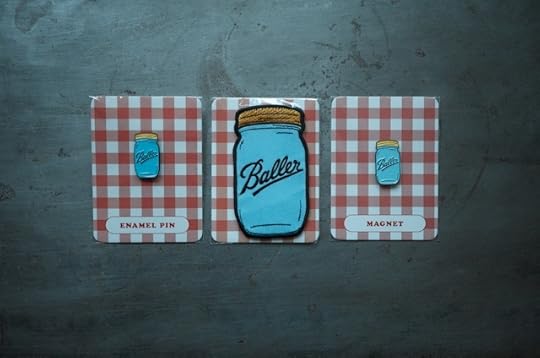
We’ve got winners in the Biscuit Press giveaway from last week! I’ll be in touch with the winners in the next day or so. If you didn’t win but loved the Biscuit Press gear, support a small business and buy a pin, patch or magnet!
And check back tomorrow, when I’ll have another tasty giveaway for you all!
Related Posts:
Links: Pickles, Trifles, and Winners
Links: Linzer Cookies, Dorie’s Jammers, and Winners
Links: Cranberries, Marmalade Pie, and a Winner
January 26, 2017
How To Check for Set With the Plate Test
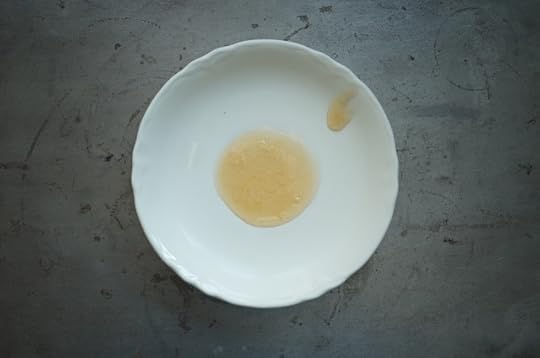
One thing I heard from a bunch of folks as they made their marmalade for the Mastery Challenge was that they struggled to find the set point. And I get it. Determining when you’ve hit the set point for jams, jellies, and marmalades can be kind of tricky, particularly if you don’t have a lot of batches under your belt.
You’ve got temperature, which is reliable most of the time, except when it isn’t (thermometers aren’t perfect and often they need to be calibrated). You can watch how the preserve sheets off the spoon or spatula, but what if you don’t know what you’re looking for? If you found yourself asking these questions as your made your marmalade, the plate test is for you.
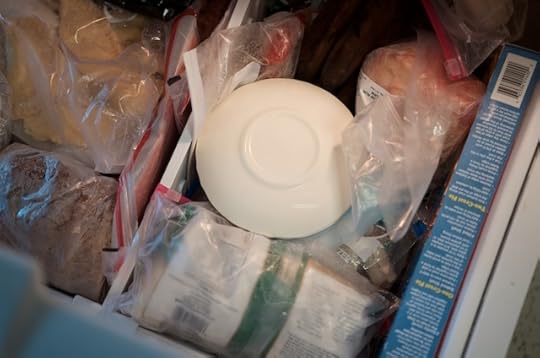
Also known as the freezer test or the saucer test, this is a method of checking for set that requires some pre-planning. You need to stash a couple small bowls, plates, or saucers in your freezer before you start cooking the marmalade, so that they’ll be nice and cold when you’re nearing the end of the cooking process.

When you hit the point when you think the marmalade is finished, you remove the pot from the heat and dollop a spoonful of marmalade onto the frozen plate. Then, you return the plate to the freezer for a few minutes. This accelerates the setting process and gives you a peek into the future of your marmalade.
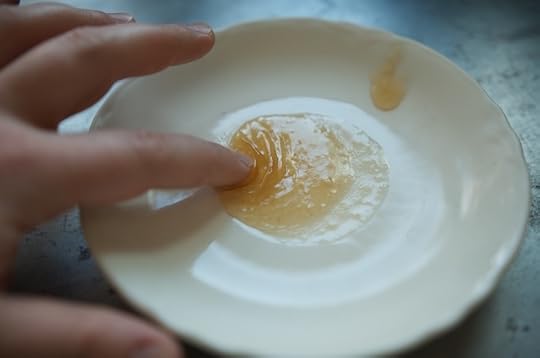
After those few minutes are up, you pull that plate out of the freezer and give the dollop of marmalade a nudge with the tip of your finger. If a set has begun to form, it will wrinkle when you push it (as demonstrated in the picture above). If that’s the case, it is done. If the marmalade hasn’t set, your finger will slide right through the dollop and you’ll need to cook the marmalade a bit longer.
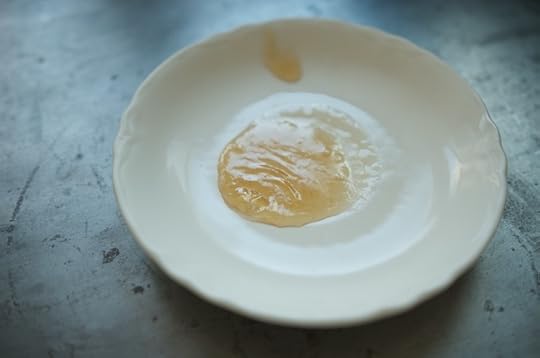
Do take care to pull the pot off the heat while you’re running this test. If you let the preserve continue to cook while you’re waiting to see if it’s going to set up, you run the very real risk of overcooking and scorching.
Related Posts:
Mastery Challenge: Meyer Lemon Grapefruit Marmalade
How to Submit Your Marmalade for the January #fijchallenge
How to Make Small Batch Marmalade
January 25, 2017
Lemon Lime Marmalade
One more marmalade for the January challenge. This small-ish batch of lemon lime marmalade is made over the course of three days. That better allows you to fit your preserving into your busy life!

We’re beginning to wrap up our month of marmalades in the Food in Jars Mastery Challenge and I figured the best way to celebrate was with more marmalade! Lemon lime marmalade, to be precise. This is a batch I made about a week ago, over the course of three days (because marmalades are flexible like that).
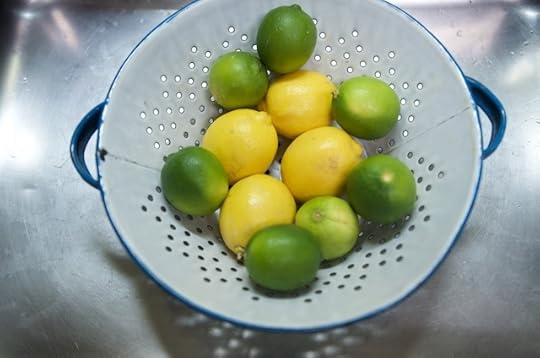
For this batch, I picked up two pounds of organic lemons and limes from my neighborhood Trader Joe’s. There was a lot of talk about sourcing fruit for this month, and part of my goal with this recipe is to show that you don’t have to go crazy or spend a ton of money to get good fruit for preserving. I don’t remember how much I paid for these lemons and limes, but it was well south of $5.
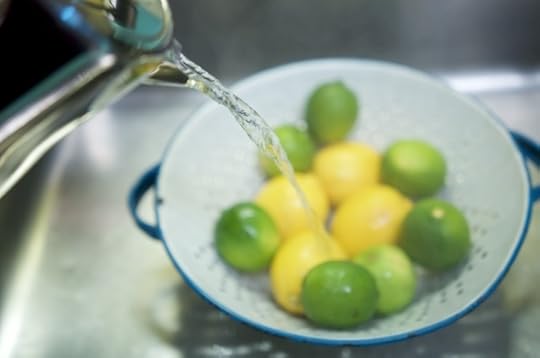
Because grocery store citrus is often waxed to help retain moisture and freshness, I always give it a rinse with boiling water if I plan on using the zest or rind. I put a colander in the sink, fill it up with the fruit, bring a kettle to a boil, and then give the fruit a scalding bath. This helps remove any surface wax and gives you a aromatic steam facial, to boot.
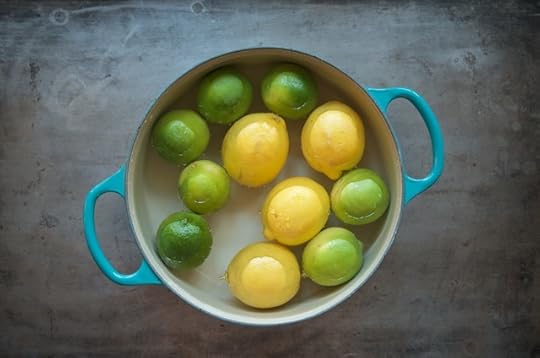
After rinsing the fruit, I arranged it in a pan that was wide enough to hold it in a single layer. Filled with twice as much filtered water as I needed for the recipe (to ensure that there would be enough after evaporation), it went on the stove and simmered for about 45 minutes, until the rinds could easily be pierced with a fork.
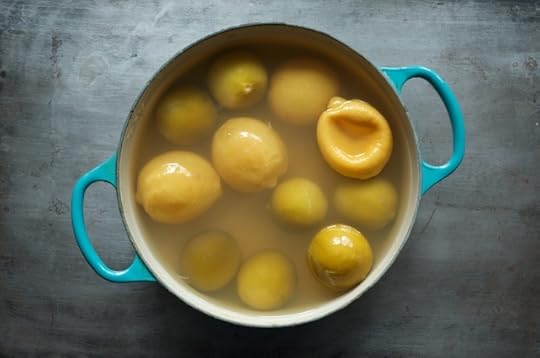
Once the fruit was cooked through, I turned off the heat and let it sit until cool. That was the end of the day one prep. I covered the pan and let it hang out on the back of the stove until the next day.
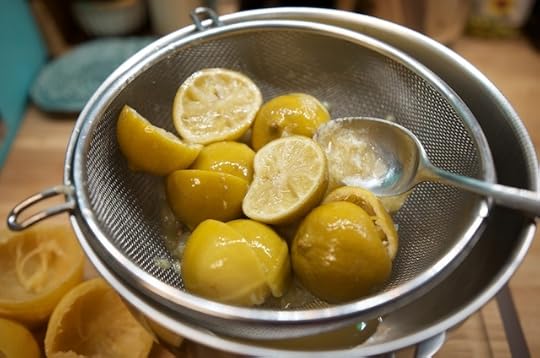
On day two, I pulled the fruit out of the pot and set it on a cutting board with a carved groove to catch any juices. I measured out four cups of cooking water to use in the marmalade and set to work breaking down the citrus. I positioned a fine mesh sieve over a bowl. With a piece of citrus in my left hand and a paring knife in the right, I cut the fruit open over that sieve.
Once about half the fruit was cut open, I scraped all the flesh (membranes and seeds included, but not the pith) into the sieve. I set the rind aside for a moment. Then I used the sieve to work through the pulp in order to remove the seeds. Once I was certain that all the seeds were removed, I poured the pulp into the bowl below. This process was repeated until all the deseeded pulp was in the bowl.
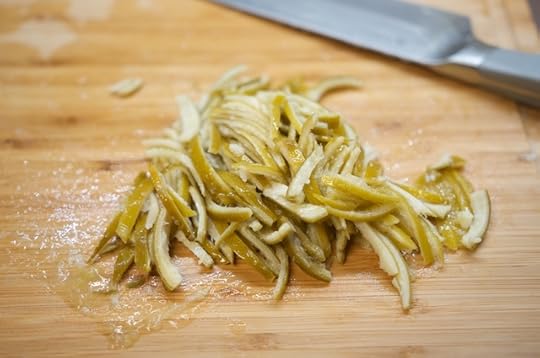
Then I chopped the rinds into strips. I like to take a couple empty rind halves, cut them in halves or quarters, make a neat stack, and chop through them. This keeps the task from becoming too tedious (but there’s always a little tedium in making marmalade. It’s just part of the gig).
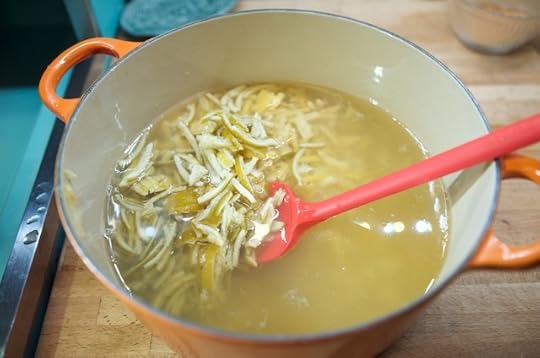
Once all the rinds were chopped, I heaped them in a five quart pot and added the four cups of reserved cooking water, all the pulp and juices from the bowl beneath the sieve, and four cups of sugar (I know it seems like a lot, but I was working with the 1:1:1 ratio. Two pounds of fruit, two pounds water (four cups = 32 ounces = 2 pounds), and two pounds of sugar (like the water, four cups = 32 ounces = 2 pounds).
I put a cover on the pot and slid it to the back of the stove to wait until morning.

On the morning of day three of the lemon lime marmalade, I took a picture of the prepared fruit in nice light and then got to cooking. I placed the pot on the stove, set the burner to high, and brought it to a boil. Once it started to roll, it boiled steadily for 35 minutes before it started nearing the set point.
I stirred occasionally at the start of cooking and regularly towards the end. Around minute 40, it reached 220 degrees F and was able to maintain that temperature even after being stirred. I also used the saucer test and looked at how the droplets were setting up on the spatula before calling it done.

This batch was so eager to set up that it started to do it in the pot while I was taking these pictures (and truly, when I take pictures of a finished preserve in the pot, it only adds a couple minutes to the workflow. This pot wasn’t off the stove long). But you can see that as I tilted the pot a little, the surface wrinkled in the same manner we look for when using the plate/saucer test to check for set. Set mission accomplished.
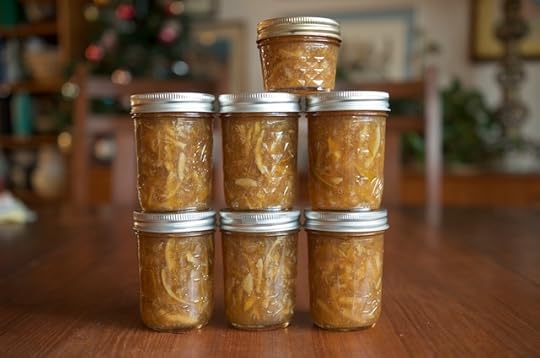
This batch yielded six half pints and one quarter pint. It’s pleasingly bitter and bracing. I made a batch of lemon chicken the other night and used a few spoonfuls to lend flavor to the quick-cooking dish. Easy and delicious!
PrintLemon Lime Marmalade
Yield: between 6-7 half pints
Ingredients
1 pound organic lemons1 pound organic limes
8 cups water
4 cups sugar
Instructions
Day one:If your citrus is waxed, put it in a bowl or colander in the sink. Bring a kettle of water to a boil and just as soon as it boils, use that water to rinse the fruit.
Arrange the lemons and limes in a single layer in pot. Cover with the water and bring to a boil. Once the water boils, reduce the heat to medium and simmer for about 45 minutes. They are done when the rind can easily be pierced with a fork.
Day two:
Remove the lemons and limes from the pot. Measure out 4 cups of the cooking water to use in the final cook.
Position a fine mesh sieve over a bowl. Hold the fruit over the sieve, cut them in half across their mid-section, the way you would a grapefruit. Using a spoon, scoop the interior flesh (membranes and all) out into the sieve. Remove the seeds and discard them. Put the seeded pulp into the bowl. Repeat with the remaining halves.
Once all the pulp is in the bowl, turn your attention to the rinds. Cut each half into 4 wedges and then cut those wedges into thin strips.
Combine the citrus pulp, chopped rind, reserved water, and sugar in a pot that holds at least five quarts. Cover and let it sit over night.
Day three:
Prepare a boiling water bath and 6-7 half pint jars.
Place the pot containing the citrus pulp, rinds, water, and sugar over high heat and bring to a boil. Cook at a controlled boil, stirring occasionally, for 30 to 35 minutes, until the volume in the pot has reduced by about half.
Monitor the temperature of the cooking fruit using an instant read thermometer. The marmalade is done when it reaches 220F. When it reaches that point, remove the pot from the heat. If desired, us the plate test to check for set at this point.
Funnel the marmalade into the prepared jars, leaving 1/2 inch headspace. Wipe the rims, apply the lids and rings, and process in a boiling water bath canner for 10 minutes.
When the time is up, remove the jars and set them on a folded kitchen towel to cool. When the jars have cooled enough that you can comfortable handle them, check the seals. Sealed jars can be stored at room temperature for up to a year. Any unsealed jars should be refrigerated and used promptly.
3.1http://foodinjars.com/2017/01/lemon-lime-marmalade/
Related Posts:
Mastery Challenge: Meyer Lemon Grapefruit Marmalade
How to Submit Your Marmalade for the January #fijchallenge
Marmalade Troubleshooting
January 24, 2017
Cookbooks: Eat It Up by Sherri Brooks Vinton
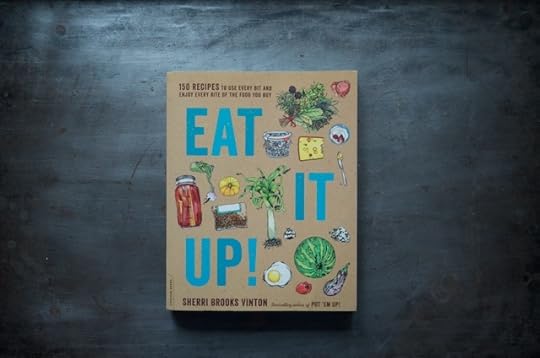
There is little in life I find more satisfying that making a meal that uses up things that might otherwise get thrown away. Leek tops? A batch of veggie stock, which then becomes risotto, soup, or a cooking medium for whole grains. Random, limp vegetables? Soup, fried rice, or egg scramble. Stale bread? Bread pudding, savory panade, meatball or meatloaf binder, panzanella, or toasted bread crumbs.

However, having spent some time with Sherri Brooks Vinton‘s relatively new book (it came out last June), Eat It Up!, I’ve come to realize that there’s even more I could be doing to use things up and prevent waste in my kitchen.
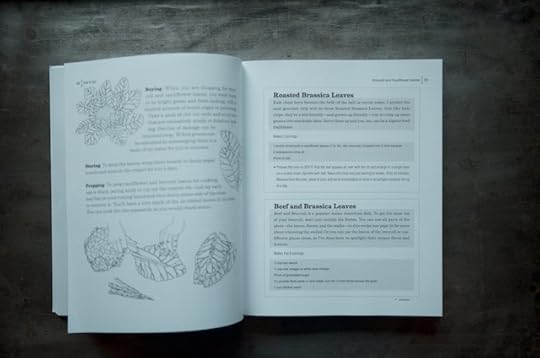
Sherri begins the book with an introduction that defines the problem of food waste and identifies reasons why so many are striving to reduce it. From there, she heads off into techniques and recipes for using up unloved bits and transforming scraps into delicious dishes.

In the produce section, Sherri focuses primarily on the parts that we most often toss into the trash or compost. She’s included recipes that make good use of apple peels, celery leaves, the stems from various greens, fennel fronds, and the tops of radishes, turnips and beets.
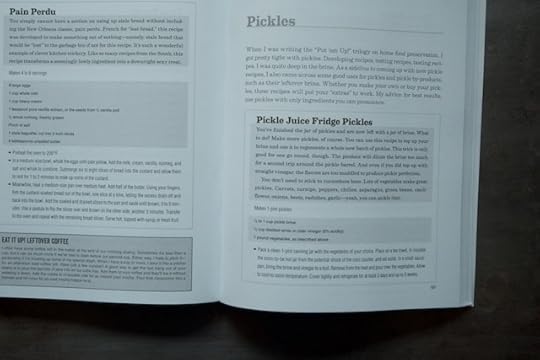
In the meat section, she shows you how to make stock, prepare bone marrow, render fat, and transform those things into tasty dishes. Hit the dairy section of the book to use up scraps of cheese, the end of a tub of yogurt, and make queso fresco. There are suggestions for the ends of condiments, leftover baguettes, and the olives that invariably remain after you’ve thrown a party.
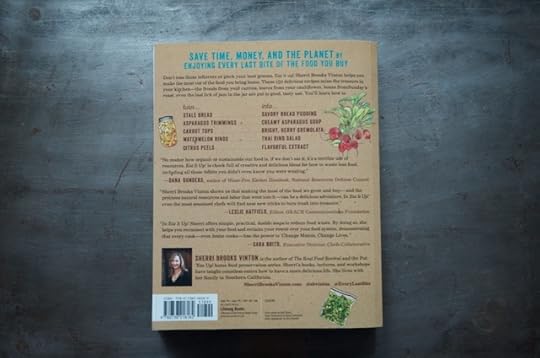
If one of your resolutions for 2017 was to do better with food waste, I highly encourage you get yourself a copy of this book. It’s bursting with useful tips (potato peel croutons!) and is friendly, approachable, and fun.
Related Posts:
Cookbooks: The Perfect Blend by Tess Masters
Cookbooks: Preserving Italy by Domenica Marchetti
Cookbooks: Batch
January 23, 2017
Giveaway: Baller Gear from Biscuit Press

Both the silhouette of a mason jar and its embossed label are instantly recognizable. And any time something has such an iconic look, it becomes a candidate for interpretation and artistry. I see reinterpretations of the canning jar’s form and branding regularly and I’m often delighted by the creativity and imagination that goes into the work.

One of my current favorite takes on the classic Ball jar comes from Austin’s Biscuit Press. The brainchild of designer and musician Dan Grissom, he uses the familiar jar shape and scrolling text to say Baller. Love. It.

You can get your Baller gear from Biscuit Press in either a iron-on patch, an enamel pin, or an enamel magnet (Dan also makes an array of other clever pins and magnets).
Thanks to Dan, I have three sets of Baller patches, pins, and magnets to give away to you guys. Use the widget below to enter the giveaway.
Related Posts:
Giveaway: Smooth Sided and Mini Jars from Ball Canning
Links: Linzer Cookies, Dorie’s Jammers, and Winners
Giveaway: EcoJarz PopTop and Jar Band Gripper
January 18, 2017
Mastery Challenge: Meyer Lemon Grapefruit Marmalade
Hey folks! Let’s welcome Alex Jones to the blog. She’s a friend and fellow Philadelphian who is coming on board as a regular contributor to Food in Jars (you’ll see her posts a couple times a month). She’ll be participating in the Mastery Challenge and will be sharing preserving tips and recipes from her West Philly kitchen. She’s kicking things off with a batch of Meyer Lemon Grapefruit Marmalade! ~Marisa
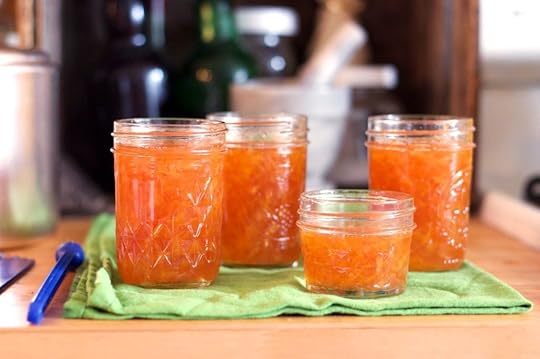
Hello fellow canners! I’m Alex Jones, your new FIJ contributor. I write about and work with local foods, farmers, and makers in the Philadelphia area. Over the past several years, I’ve learned to preserve thanks in large part to Marisa’s blog, books, and classes, so it’s especially exciting to lend my voice to the blog.
For January’s Mastery Challenge, I knew I’d be incorporating some of my Lemon Ladies Meyer lemons, which have become a permanent line item on my Christmas wish list. After slicing and drying half my stash, turning some into thick, sliceable fruit cheese, and squeezing a few over seared day boat scallops, I had half a dozen lemons left to make into marmalade.
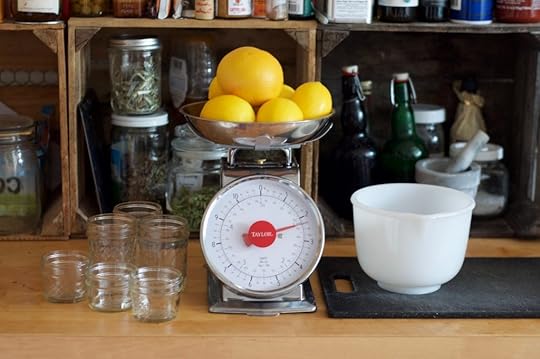
To fill out the recipe and add a rosy glow to the finished product, I grabbed an organic grapefruit that had been hanging out on my counter. In total, I had a little over two pounds of fruit, just enough to halve Marisa’s Three-Citrus Marmalade recipe and transform it into a batch of Meyer Lemon Grapefruit Marmalade.
I grabbed my peeler and my paring knife and got to work. The methodical process of zesting, trimming, supreme-ing, and chopping my lemons and grapefruit, as the canning pot warmed my kitchen and episodes of Scandal hummed in the background, was the perfect way to spend a cold January morning.
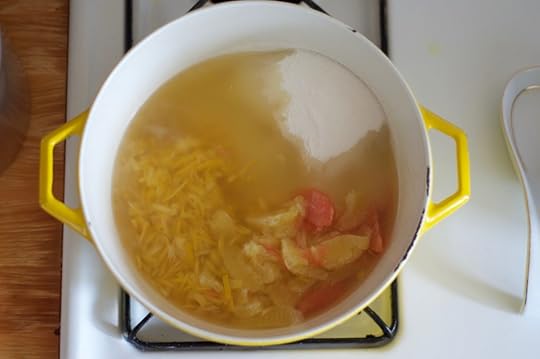
I followed Marisa’s recipe as closely as possible — something I admit I don’t always do when in the throes of bulk fruit season — and for the most part, my results corresponded closely with her version. The main difference was around what for me is the most challenging aspect of making fruit preserves like this: achieving set.
I shy away from jam recipes that include store-bought pectin, as I often end up with an unappetizing, too-firm preserve, rather than the desired substantial-yet-stirrable set. But this marmalade recipe makes use of discarded bits of citrus — the seeds and membranes from the sections — as a gentle thickener.
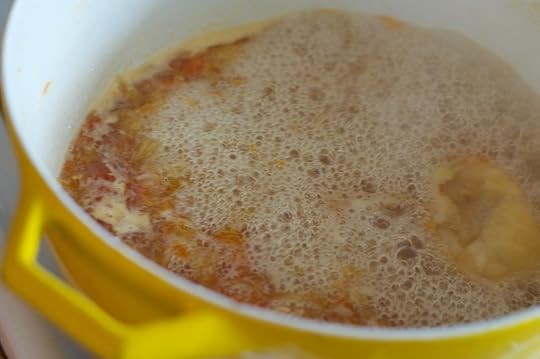
My Meyer lemon-grapefruit marmalade, cooked over medium-high gas heat in a 4-quart enameled cast iron Dutch oven, took 45 minutes to get to 220 degrees, at which point I began testing the set. It took another 17 minutes and 5 degrees before the marmalade passed the plate test. Constant stirring and testing every 5 minutes helped me avoid scorching the marmalade, another potential pitfall.

Before canning, I took care to remove the pot from the heat and stir for a full minute to keep the zest from floating at the top of the jar, a tip I somehow missed till now. It’s already paying off to revisit these techniques with intention!
After the processed jars had some time to cool off, I couldn’t resist popping open a quarter pint jar to check set and flavor. The texture was lovely — standing up on my knife but easy to spread — with tender bits of zest throughout. It tasted bright, sweet and sunny, with a hint of bitterness from the grapefruit to balance.

I might have to reconsider my usual policy of making fruit preserves for gifts only and allocate a jar or three of this Meyer Lemon Grapefruit Marmalade for my own use. That definitely makes the first month of the Mastery Challenge a success.
PrintMeyer Lemon Grapefruit Marmalade
Ingredients
6 Meyer lemons (about 2 pounds)1 red grapefruit (about 1/2 pound)
3 cups sugar
2 cups zest poaching liquid
Instructions
Prepare a large water bath canner and jar lids. Sanitize three clean half-pint jars by boiling the jars for 10 minutes in the canner. (I ended up with just enough marmalade to fill an additional quarter-pint jar as well.)Wash and dry the fruit. Using a vegetable peeler, remove the zest from the fruit in long, thin strips. Chop zest into short, thin ribbons and add to a stainless steel or enameled cast iron pot with 3 cups cold water. Bring to a boil, then turn heat to medium-low and simmer for 30 minutes.
While the zest simmers, prepare your fruit: Slice away the top and bottom of each piece so that you can stand the fruit up straight on your cutting board. Moving a sharp paring knife from top to bottom, trim away the white pith, turning the fruit as you go until all pith is removed. Then, supreme the fruit. Over a medium bowl, take each naked fruit in your hand and make gentle cuts on either side of the membrane separating the segments, allowing the segments and juice to fall into the bowl below. Pick out any seeds stuck in the fruit.
Once all sections have been removed, save the membranes and seeds from each piece of citrus and set aside. Tie the membranes and seeds into a secure bundle using cheesecloth.
Put a small ceramic or glass plate in your freezer. (You'll use this to check the set of your marmalade later.)
Drain the zest over a bowl to catch the poaching liquid. In the same pot you cooked the zest, combine drained zest, fruit segments, 2 cups of the zest poaching liquid, 3 cups sugar, and the bundle of membranes and seeds.
Bring to a boil over medium-high heat and let the mixture boil vigorously until it reaches 220 degrees (30-45 minutes).
When the mixture can sustain 220 degrees for one full minute, remove the cold plate from your freezer. Dab a bit of the marmalade in the center of the plate and allow it to sit for a few moments. Poke the marmalade with your finger; if the surface of the mixture wrinkles, you've achieved the proper set. If not, wipe and return the plate to the freezer, continue cooking the marmalade, and check again in five minutes, stirring frequently to keep the mixture from burning.
Once the marmalade passes the plate test, remove the pot from the heat. Stir the mixture gently for one minute. This will keep the solids from floating to the top of the jar.
Fill your jars, wipe rims, apply prepared lids, and screw on bands. Lower into prepared canner and process for five minutes at a gentle boil, counting from when the pot returns to a boil.
Remove jars to a folded dish towel on the counter and allow to cool completely. After cooling, check seals by pressing down on the top of the jar — no movement means you've got a good seal.3.1http://foodinjars.com/2017/01/meyer-lemon-grapefruit-marmalade/
Related Posts:
How to Submit Your Marmalade for the January #fijchallenge
Marmalade Troubleshooting
How to Make Small Batch Marmalade



